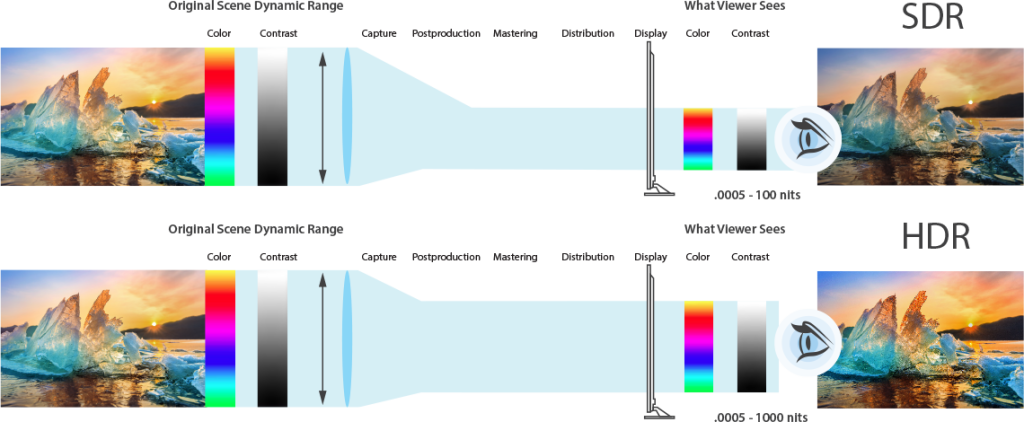I am a creative and passionate person and I have a urge to work with creative video editing, help clients to tell their stories and strengthen their brand on the right channels.
I find it interesting to work with social media, marketing strategies as well as the look, feel and moods you add to the videos so that it matches the customer profile and vibe.
Do you have an urge to work with HDR?

Here you can find all the information to get startet.
What is HDR?
The pursuit of High Dynamic Range (HDR) is the dream of getting closer to the Human Visual System (HVS) in all that we experience as viewers.
- HDR is a new display system that is designed to better represent what the human vision system (HVS) can see.
- Human vision sees the world with lots of dynamic range and a wide range of colors.
- Modern cameras have up to 14 stops of dynamic range.
- BT.709 Standard Dynamic Range (SDR) systems can show only up to the equivalent of about 6 stops.
- HDR attempts to show much more of the world we see, starting with the larger camera dynamic range available today at source and through the production chain and ultimately for presentation on affordable displays optimized for HDR.
PQ (Perceptual Quantizer) or Finding a Better Curve


To achieve a balance of getting closer to human perception within the bandwidth limitations of existing infrastructure and technologies, including chroma and luminance sampling, bit depth, and the strengths and weaknesses of Gamma vs Logarithmic curves, a better curve was needed.
Why was a better curve needed and what is the advantage of PQ*?
- Power functions waste bits at the high end of the luminance range
- Log functions waste bits at the low end of the luminance range
- Gamma fails at low luminance levels, even at higher bit depths
- Greatest efficiency would be to follow human perception
- PQ Shows balanced performance across the entire luminance range
* PQ is represented in practice by two approaches, HDR10 an open approach and Dolby® Vision, a proprietary system owned by Dolby Laboratories. Both are designed to make the most efficient use of bits throughout the range of luminance and contrast steps possible.
PQ is standardized in SMPTE ST 2084 and BT.2100 and PQ defines a curve that ensures banding is below the Just Noticeable Difference (JND). The PQ curve ensures the most efficient use of code words which minimizes the bit depth required.
HDR Approaches

Tackling the Challenges of HDR
- HDR involves the need to take disparate color spaces and logarithmic representations from various camera manufacturers and move it through the process to final delivery for emerging HDR approaches for display and delivery today.
- Broadcasters and producers want to take the wide dynamic range available from cameras and preserve as much of it as possible, to offer end viewers increased contrast and luminance ranges, a broader and richer color palette and an immersive viewing experience.
- HDR approaches avoid confusion by helping manage the color space properly, making sure applications look correct and take optimal advantage of improved display capabilities.
- One challenge is to convert from Camera formats, such as RAW and Log, to one of the emerging HDR approaches. Additionally, be able to apply and/or convert the HDR approach of choice through the editing, color correction and/or monitoring process.
- Many UltraHD displays now include HDR functionality, which provides a more realistic and immersive viewing experience. This is achieved by increasing the color space representation with Wide Color Gamut (WCG) and luminosity by using higher dynamic range (HDR).
Emergent Systems Address HDR Needs
For a vivid image, which HDR promises upon delivery to the display, the challenge has been to provide enough useful steps within the color and luminance range to provide smooth gradations and satisfy the viewer. Dolby Vision is a new way of defining how a picture looks on a TV. It is a “display referred” system where each code value defines a specific brightness (i.e. there is no user brightness control). Dolby Vision has a method to send 12-bit data down a HDMI cable utilizing 4096 shades for smooth gradations. For contemporary production pipelines, the challenge is that most pipelines are 10-bit with 1024 shades or steps available. HDR 10, Dolby Vision and HLG have been designed to solve this dilemma by efficiently choosing to utilize curves across the luminance and color ranges that minimize perceptual banding and achieve results that are closer to the human vision system, enabling incredible results.
- Proprietary format
- SMPTE ST-2084 Perceptual Quantizer (PQ)
- Metadata: Dynamic per ST 2094*
- Electro-optical transfer function, up to 4K resolution
- Playback bit depth: 12-bit
- Up to 10,000-nit maximum brightness (mastered to 4,000-nit in practice)
- Wide Color Gamut (WCG) color space (ITU-R Rec. 2020)
HDR10 is a Media Profile defined by the Consumer Technologies Association (CTA).
HDR10 uses SMPTE ST-2086 “Mastering Display Color Volume” static metadata to send color calibration data of the mastering display, as well as MaxFALL (Maximum Frame Average Light Level) and MaxCLL (Maximum Content Light Level) static values. HDR10 is an open standard supported by a wide variety of companies.
- Open format
- SMPTE ST-2084 Perceptual Quantizer (PQ)
- Minimum Signal Interface: HDMI 2.0a
- Playback color representation BT.2020 (same as Dolby Vision)
- Playback transfer function: ST 2084 (same as Dolby Vision)
- Metadata: Static per ST 2086
- Playback bit depth: 10-bit
HDR10+ builds from HDR10*, adding dynamic metadata and more, allowing for scene by scene or even shot by shot variation. The standard allows for recognizing a display’s color space and more. Samsung is the primary driver for this evolution of the original standard.
HDR10+ has recently been adopted by a range of companies and resulted in the creation of the HDR10+ Alliance with members comprising Amazon, Samsung, Panasonic, 20th Century Fox, and Warner Bros and more.
- SMPTE 2094-40 Dynamic Metadata for Color Volume Transforms (DMCVT)
- Color transforms optimized for each scene, and each display
- Metadata: Dynamic per ST 2094
- Metadata tracks carry supplementary color grading information
- Minimum Signal Interface: HDMI 2.0a
- Playback color representation BT.2020 or BT.709 dependent on display
- Playback transfer function: ST 2084
- Playback bit depth: 10-bit
HLG (Hybrid Log Gamma) is an HDR approach that was jointly developed by the BBC and NHK. HLG uses relative luminance values and builds on the BT.2020 standard for a wider color gamut and adds PQ and HLG dynamic range for a standard known as BT.2100. The HLG standard is royalty free and is compatible with SDR displays as well as HDR displays. HLG is supported by HDMI 2.0b*, HEVC, and VP9. The key appeal of HLG is that HDR content can be reasonably viewed on SDR displays.
- Hybrid between Gamma and Log
- Metadata: None
- Relative Luminance
- Very similar to SDR curve
- Playback bit depth: 10-bit
- Linear light image data from a camera is mapped to the HLG OETF Curve and to the WCG color space BT.2020
*Since HLG has no metadata, HLG works with any HDMI spec and HDMI 2.0b is a clarification of HDMI 2.0a
An example of graphics work, Colorgrading etc...
Example of social media work
Curator for this Instagram profile @thisissoestella
Brand film for Instagram profile @thisissoestella
Full version for Instagram profile @thisissoestella – All work from idea, lighting, camera work to editing is done by me.
Brand film
Editing and colorgrading is done by me.
Brand film
All work from idea, lighting, camera work to editing is done by me.
Brand film - FOXleRENARD
Garmin unboxing
Brand film for David Andersen
David has worked successfully with all aspects of brand building, Design, reporting and business strategy. He has a structured approach to streamlining and optimizing business processes. David Andersen is a very creative and design-oriented person, always looking for a good idea.